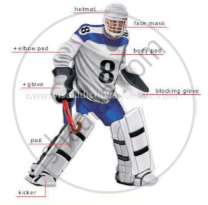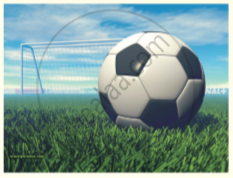Advertisements
Advertisements
प्रश्न
Form pairs - one student will read the text for 'Hockey', and the second student will read the text for 'Football'.
Hockey

The game starts when the umpire blows his whistle for the opening pass-back. The passback is made at the centre of the field to start the game (also after half- time and after each goal is scored). The ball, which may be pushed or hit, must not be directed over the centre line. All players of the opposing team must stand at least 5 yard from the ball and all players of both teams, other than the player making the pass-back must be in their own half of the field.
There are two umpires to control the game and to administer the rules. These umpires are the sole judges of the game. The umpires are responsible for keeping time for the duration of the game.


In front of each goal is an area known as the penalty area. This is a rectangular area, 40.2m wide and extending 16. Sm into the field where the goalkeeper operates.
A standard adult football match consists of two periods of 45 minutes each, known as halves. Each half runs continuously, meaning that the clock is not stopped when the ball is out of play. There is usually a 15-minute half-time break between halves. The end of the match is known as full-time. Anytime during the match, a team can substitute upto three players maximum.
The game is controlled by a referee who is the official timekeeper for the match, and may make an allowance for time lost through substitutions, injured players requiring attention, or other stoppages. There are also two linesmen who keep guard of the touchlines or sidelines, signalling when the ball crosses the boundary lines. The referee alone signals the end of the match.
Handling the ball deliberately, pushing or tripping an opponent, or hitting a player from behind are examples of fouls, punishable by a direct free kick or penalty kick depending on where the offence occurred. Other fouls are punishable by an indirect free kick.
The referee may punish a player's or substitute's misconduct by a caution (yellow card) or sending-off (red card). A player is given a yellow card is said to have been 'booked'.
• Red - Serious misconduct resulting in ejection from the game. If a player has been sent off, no substitute can be brought in his place.
उत्तर
For Self - Attempt
APPEARS IN
संबंधित प्रश्न
Six humans trapped by happenstance
In black and bitter cold.
Each one possessed a stick of wood,
Or so the story's told.
Their dying fire in need of logs;
The first man held his back.
For on the faces around the fire,
He noticed one was black.
Read the lines given above and answer the question that follow:
What do the logs denote?
Some are like fields of sunlit corn,
Meet for a bride on her bridal morn,
Some, like the flame of her marriage fire,
Or, rich with the hue of her heart's desire,
Tinkling,luminous,tender, and clear,
Like her bridal laughter and bridal tear.
Read the lines given above and answer the question that follow.
The poet has used several expressions which form pictures in the readers mind “fields of sunlit corn” and “circles of light”. Pick out more such expressions from the poem.
The king had done right things at the right time. Explain giving three examples.
Mridu had noticed in front of Meena’s house a pair of chappals. Whom did they belong to?
Why is it a great pleasure to walk through the meadows?
Multiple Choice Question:
What does the word ‘groomed” here mean?.
Multiple Choice Question:
What type of people do entertain such fears?
Answer the following question.
Why was Jumman happy over Algu’s nomination as head Panch?
Read the passage given below and answer the questions (i), (ii) and (iii) that follow:
|
(1) |
Something happens to cats after we have enjoyed a delicious meal. Call it a feline sugar hit or a rush of good feelings. Abandoning our usually sedentary nature, we transform into crazy beasts who thunder down corridors, spring from one piece of furniture to another, or pounce from behind half-closed doors to attack the shoelaces of unsuspecting passersby. It is as though we are temporarily possessed. |
5 |
|
(2) |
That, at least, is my excuse, dear reader - and the only explanation I can offer for my entirely unplanned global TV debut. |
|
|
(3) |
To be fair, I had no way of knowing that my master was receiving visitors that particular afternoon. Nor that he was being interviewed live, let alone by one of America’s most famous journalists. |
10 |
|
(4) |
All I knew was that, a few minutes after gorging myself on a favourite treat of creamy pudding, I felt that sudden, primal explosion of energy. I made my way back to the suite of rooms that I shared with my master and felt an overpowering compulsion to do something completely mad. I wanted to run like a furious jungle cat, at that particular moment. |
15 |
|
(5) |
Bursting through the door of the room in which my master received visitors, I tore up the carpet as I raced towards the sofa opposite where he was sitting. I ripped its fabric as I scrambled up its side like a savage creature clawing its way up a perilous cliff. Then with a final, frenzied burst, I launched myself off one arm of the sofa, leaping towards the other. |
20 |
|
(6) |
It was only at this point that I realised the sofa was occupied by the journalist. She was halfway through a sentence, and my abrupt appearance caught my master's guest completely by surprise. |
|
|
(7) |
You know, when something truly unexpected happens, time can seem to slow down. Well, that’s how it was. As I flew past the woman's face, her expression turned from one of calm engagement to that of total surprise. |
25 |
|
(8) |
I As she pushed back in her seat to avoid me, the shock on her face could not have been more evident. |
|
|
(9) |
But, dear reader, she was not more shaken than me. I had not been expecting anyone on the sofa, let alone a TV celebrity, nor one who was mid-interview. As I headed towards the opposite end of the sofa, for the first time I observed the lighting, the cameras and the crew watching the action from the shadows. By the time I landed on the other arm of the sofa, all the energy that had propelled me was gone. |
30
35 |
|
(10) |
I was, no longer, a furious jungle cat. |
|
|
(11) |
The journalist looked at me. I looked at her. Both of us were taking in what had just happened. I was also conscious of the cameras still rolling as well as many pairs of eyes watching me at that moment. My moment of global glory. |
|
|
|
Adapted from: The Dalai Lama's Cat Omnibus |
|
(i)
- Given below are three words and phrases. Find the words which have a similar meaning in the passage: [3]
- inactive
- eating in a greedy manner
- dangerous
- For each of the words given below, write a sentence of at least ten words using the same word unchanged in form, but with a different meaning from that which it carries in the passage: [3]
- thunder (line 3)
- spring (line 3)
- past (line 26)
(ii) Answer the following questions in your own words as briefly as possible:
- What is the usual nature of the narrator's kind? How is it differently presented in the passage? [2]
- What did the 'favourite treat of creamy pudding' do to the narrator? [2]
- Describe the actions of the narrator after bursting into the visitors' room. [2]
- How did the journalist react when the narrator 'flew past' her face? [2]
(iii) Summarise how the narrator became a global celebrity (paragraphs 4 to 11). You are required to write the summary in the form of a connected passage in about 100 words. Failure to keep within the word limit will be penalised. [6]
Complete the following sentence by providing a reason:
In Act III, Scene II of the play, The Tempest, Stephano threatens to tie Trinculo to the next tree because ______.
